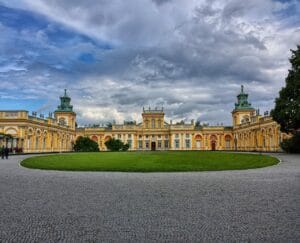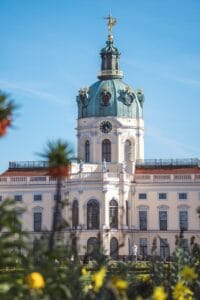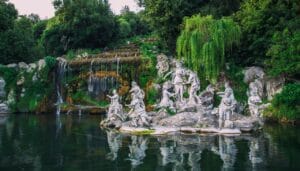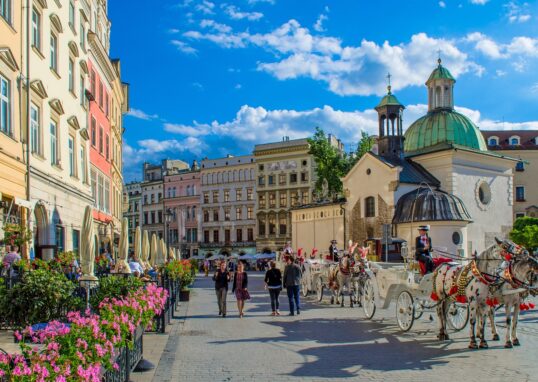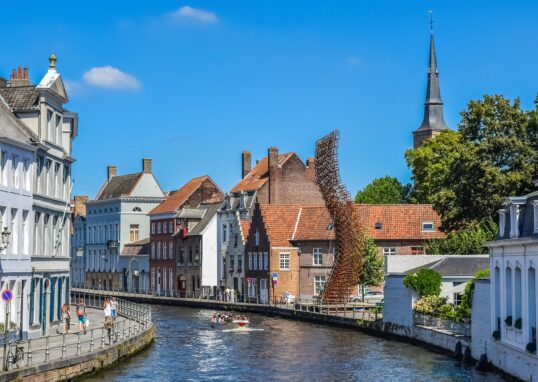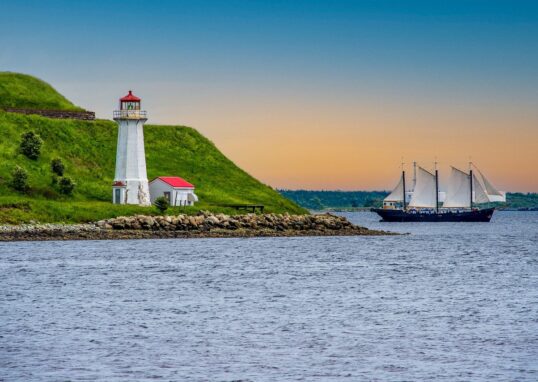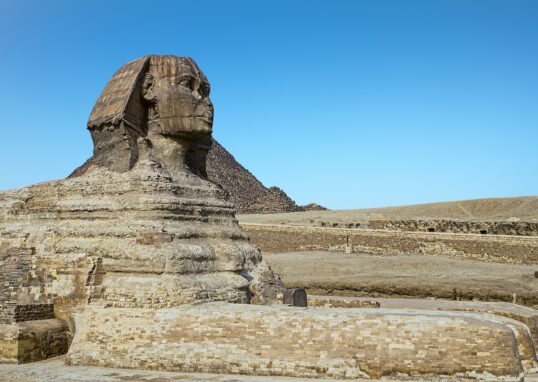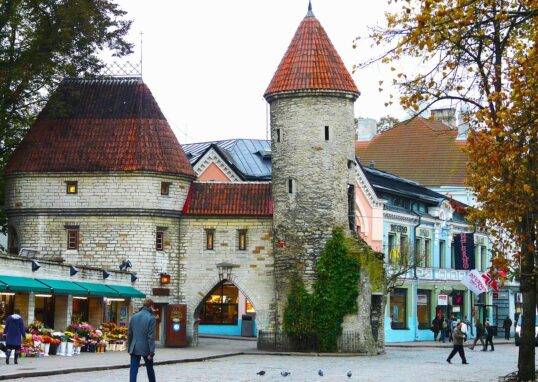
✨ The Royal Palace at Caserta: A Journey into Italian Grandeur
Italy is a nation full of art, culture, and beauty. Each corner from Rome to Venice has a tale to tell. But there is one that stands out because of its sheer size and grandeur. This is the Royal Palace at Caserta, or the Reggia di Caserta. The Royal Palace of Caserta is also known as the “Versailles of Italy.” It was built in the 18th century to compete with the other great courts of Europe. Along with its vast park, the Aqueduct of Vanvitelli, and the San Leucio Complex, it forms a UNESCO World Heritage Site. This amazing location is a mix of architecture, engineering, and vision. It resonates with the power and ambition of the Bourbon rulers of Naples. At the same time, it is the story of human skill, aspiration, and artistic excellence. In this blog, we are going to explore the Royal Palace and its riches. We are going to take a look at its history, its royal rooms, the gardens, the aqueduct, and San Leucio. Finally, we are also going to reveal the surrounding areas that make Caserta a special location.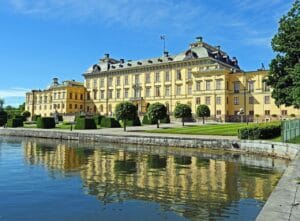
📖 The History of the Royal Palace at Caserta
The Vision of Charles VII
The tale starts with Charles VII of Bourbon, King of Naples and Sicily. During the mid-18th century, Charles wished to display his strength to the world. He had a dream of a palace that would match the glory of Versailles in France and the Escorial in Spain. Caserta, a town near Naples, was chosen as the site. It was safe from seaward attack and had a strategic location in the Campania plain, which was fertile.
The Architect – Luigi Vanvitelli
Charles chose Luigi Vanvitelli, one of the greatest architects of the time, to realize this dream. Vanvitelli was a master of the Baroque and neoclassical architectural style. His buildings blended strength and beauty, function and harmony. Construction began in 1752. Vanvitelli worked tirelessly, not just designing a palace but a whole royal town. Sadly, he did not live to see the entire project through. Carlo Vanvitelli, his son, and other architects continued the work.
A Symbol of Power
The Royal Palace was more than a dwelling. It was a political symbol of power. It was a manifestation of the wealth and ambition of the Bourbon dynasty. It reflected their association with Italian tradition and European culture. By the late 18th century, the palace was ready to receive kings, queens, diplomats, and visitors from around the globe. Its beauty made an impression on everyone who came to visit.
🏰 The Royal Palace: A Masterpiece of Architecture
The Size and Layout
The Royal Palace of Caserta is one of the largest palaces in the world. It covers an area of 235,000 square meters. It has 1,200 rooms, 34 staircases, and 24 state apartments. The palace was designed in the shape of a rectangle with four enormous courtyards. From the air, the palace is seen as a perfect, symmetrical plan. This symmetry is one of its most astonishing features.
The Grand Staircase
One of the most renowned sections of the palace is the Grand Staircase of Honor. Guests come in and are instantly amazed. The staircase itself is marble, with 116 steps curving upward in grace. At the top, lion statues stand guard at the doorway. Light from above illuminates the entire hall. It’s like entering a different world.
The Royal Apartments
The palace apartments are richly adorned. Each room contains lavish paintings, stuccoes, and furnishings.
- Throne Room – The largest and most magnificent of all the rooms. It is gold-decorated and has a high ceiling with frescoes. It was used for the hosting of important ceremonies.
- Palatine Chapel – The chapel was modeled after Versailles and is simple yet elegant. It demonstrates a mix of Baroque and neoclassical style.
- Royal Bedrooms – The king’s and queen’s rooms are richly decorated, with silk drapes and carved wood.
- Library and Theaters – The palace also has a library filled with rare books and a court theater for performances.
Every corner of the palace shows art and detail. Walking through the halls feels like walking through history itself.
Art and Symbolism
Vanvitelli’s design was not just about size. It was about meaning. Many rooms are decorated with allegorical paintings showing virtues like justice, wisdom, and strength. This reminded visitors of the king’s role as protector and leader. The palace also shows the shift from Baroque richness to neoclassical clarity. It bridges two great styles in European history.
🎨 The Artistic Legacy
The palace attracted artists from all over Italy and Europe. Painters, sculptors, and decorators worked together. They together produced one of the most handsome royal palaces in the world. Frescoes show mythological scenes, battles, and royal victories. Sculptures animate halls and gardens. Furniture shows the best 18th-century craftsmanship.
The Royal Palace at Caserta with the Park, the Aqueduct of Vanvitelli, and the San Leucio Complex
Italy is an art, history, and culture-filled country. Every city hides a treasure. One of the most stunning treasures is the Royal Palace at Caserta. It is not just a palace. It is a world of art, architecture, gardens, and dreams. The palace is compared to France’s Versailles, yet it has its own unique charm and power. The Royal Palace of Caserta, its vast park, the Vanvitelli Aqueduct, and the San Leucio Complex form a UNESCO World Heritage Site. These locations tell us about royal ambitions, innovative engineering, and the vision of creating a modern society.
History of the Royal Palace at Caserta
The palace was commissioned in the 18th century by Charles VII of Naples, the King of Naples. He wanted a grand palace that would be equal to the European palaces. He commissioned Luigi Vanvitelli, a renowned architect, to design it. They began building it in 1752. The project was ambitious. It included not only the palace but also gardens, fountains, and a new aqueduct. The building symbolized power, culture, and the strength of the Bourbon dynasty. Later, when Charles was made the King of Spain, his son Ferdinand IV continued the work. The palace soon became the royal residence of the Bourbon kings of Naples.
Architecture of the Palace
The Royal Palace is massive. It has more than 1,200 rooms, 34 staircases, and hundreds of windows. Its architecture is a mix of Baroque and Neoclassical styles. The façade is simple but imposing. The palace stretches out in long lines, creating an impression of endless space. The interior is richly adorned with frescoes, marble, and gold.
Some of the highlights include:
- The Grand Staircase of Honor: A monumental marble staircase to the royal apartments. The Palatine Chapel: Inspired by Versailles, with exquisite decorations and religious art.
- The Throne Room: Wide, stately, and adorned with gold decorations. The Court Theater: Built as a small opera house, perfect for royal entertainment.
Luxury is shown everywhere, but also balance. The palace is not just big; it is harmonious.
The Park of Caserta
The park, which covers more than 120 hectares, is at the back of the palace. The layout of the park combines Italian and French garden styles.
The Italian Garden
Close to the palace, the Italian Garden shows strict geometry. Paths, hedges, and flowerbeds are in immaculate lines. Statues add beauty and elegance.
The English Garden
Further away, the English Garden has a different atmosphere. It was created in the 18th century for Queen Maria Carolina. It has a natural look, which is different from the Italian garden. Lakes, small woods, and winding paths create a sense of romance and freedom.
Fountains and Waterfalls
One of the most dramatic features is the long watercourse with fountains. Water flows from the palace to the Grand Cascade. Along the way, you have fountains dedicated to mythological scenes:
- Fountain of Diana and Actaeon Fountain of Aeolus Fountain of Venus and Adonis
Each fountain is decorated with statues and placed amidst greenery. The final waterfall, the Grand Cascade, is breathtaking.
The Aqueduct of Vanvitelli
To supply water to the fountains, a huge project needed to be initiated. Luigi Vanvitelli designed the Carolino Aqueduct, or the Aqueduct of Vanvitelli. The aqueduct is about 38 kilometers long. It brings water from the Taburno mountains to Caserta. The most famous part is the arched bridge near Maddaloni, which has the appearance of a Roman aqueduct. This was an engineering feat of its time. It illustrates the Bourbon monarchs’ aspiration to combine science and art.
The San Leucio Complex
Near the palace is San Leucio, a social and industrial experiment like no other. King Ferdinand IV wanted to create a community dedicated to silk production. He founded the Silk Factory of San Leucio in 1778. It provided its workers with housing, education, and healthcare. The king even wrote special laws, the “Statuti di San Leucio,” that promoted equality and education. Silk produced here became famous all over Europe. San Leucio is still famous for its luxury silk products. A walk through San Leucio brings to view the remains of the silk factory, workers’ residences, and the Belvedere Palace. It is a dream of a more equal society.
UNESCO Recognition
The Royal Palace, the Park, the Aqueduct, and San Leucio were designated a World Heritage Site by UNESCO in 1997. Why? This site is the pinnacle of 18th-century planning and architecture. It shows how art, technology, and social thinking can be combined.
Surrounding Places to Visit
A trip to Caserta is not just about the palace. The area is surrounded by history, nature, and culture.
Naples
Only 40 km away, Naples is bustling. You can visit Piazza del Plebiscito, the Naples Cathedral, and the famous National Archaeological Museum. Naples is also the birthplace of pizza, so don’t forget to have it here.
Pompeii and Herculaneum
These two cities were destroyed by the 79 AD eruption of Mount Vesuvius. Now they are incredible archaeological excavations. A stroll through the streets of Pompeii is like a journey through the past.
Mount Vesuvius
The volcano still towers over the Bay of Naples. You can hike to the crater rim and take in breathtaking views of the surrounding area.
Amalfi Coast
If you have a little more time, the Amalfi Coast is close by. Towns like Amalfi, Positano, and Ravello offer brightly colored houses, blue seas, and breathtaking views.
Capua
Close to Caserta, the town of Capua features a Roman amphitheater, second only in size to Rome’s Colosseum.
Benevento
Another nearby city, Benevento features Roman ruins and a strong medieval flair. Don’t miss the Arch of Trajan.
Visitor Information
- Opening Hours: The park and palace are usually open daily, except for Tuesdays.
- Tickets: Joint tickets for the palace, park, and other sights can be bought. It is recommended to book online.
- Transport: Caserta can be easily reached by train from Rome or Naples. The palace is a short walk from Caserta train station.
- Tips: Comfortable shoes are a must, as the park is vast. Bring water, especially in the summer.
Conclusion
The Royal Palace of Caserta, the Park, the Vanvitelli Aqueduct, and the San Leucio Complex are more than monuments. They are manifestations of human creativity and aspiration. They combine art, nature, engineering, and social vision. A walk in the palace, you feel the might of kings. A stroll in the park, you see the harmony between man and nature. Looking at the aqueduct, you wonder at human ingenuity. A visit to San Leucio, you dream of a world of equality and efficiency. Together, they make Caserta a unique spot in Italy and in the world. For tourists, this destination is not only beauty. It is also history, concepts, and inspiration. If you’re going to be visiting southern Italy, Caserta is a destination that needs to be on your itinerary. It’s a step backward in time, but also a thought toward the future.

